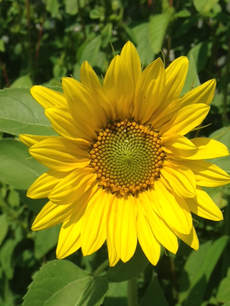 Nature's incredible fractals Nature's incredible fractals Breathing. Is something we all need to do a little more of. Breathing is important for so many reasons!! The lungs help in detoxification of the body as the carbon dioxide that we exhale is a waste product of every cell in our body. Carbon dioxide is generated in the process of generating cellular energy. One might argue that breathing is the most crucial of all routes of elimination. To notice the immediacy of its effect, try to stop breathing for five minutes. The carbon dioxide must be removed from the body for the blood to exchange it for more oxygen. Oxygen in turn yields more energy and the cycle begins again. By exhaling carbon dioxide and exchanging it for oxygen, the lungs also maintain tight control over the acid/base balance of the blood and surrounding tissues. Carbon dioxide acts as an acid in the body and inflammation occurs when excess acidity accumulates. In fact, you cannot have inflammation without acidity. In addition, the lungs serve a crucial rhythmic role in the body. In synch with the heartbeat, the breath rate can be calming to the nervous system by stimulating the vagus nerve rhythmically. We obtain a great amount of benefit to our emotional stability, mental focus and stress levels by incorporating deep breathing into our daily routine. One inhalation should last the same amount of time as five heartbeats and an exhalation as much as ten beats of the heart. Just as we eat, sleep and work in synch with the circadian rhythm and women (should) menstruate with the lunar cycle, the breathing/heart rate acts as a lesser rhythm which synchronizes our body’s physiological activity. When these internal clocks become inconsistent, the body suffers multiple hormonal and nervous imbalances that can lead to numerous physical complaints including poor sleep, weight gain, aches and pains, digestive distress, fatigue, variations in mood, headaches, and many more. Energetically, the lungs are the organs of communication. Not only do the lungs generate the air that passes over the vocal chords to produce speech, but TREES take in the carbon dioxide we exhale and, in turn, give off the oxygen we breathe. This give and take communication between ourselves and the outside world integrates our human physiology into a larger universal scheme. In addition, the lungs in Chinese medical theory represent the organ of grief. So, when examining the underlying reasons for any lung symptoms, your naturopath might consider these energetic influences. How To Integrate This Practice Into Our Daily Lives: To start, we suggest that you incorporate 100 deep conscious breaths per day into your routine. Deep means breathing into your belly, not into your shoulders. Your belly should fill up first followed by your chest. Conscious means that you are thinking about breathing while you are doing it. Placing your attention on your breathing increases the stress management benefits of this exercise. All you do is count as you inhale slowly and, then, exhale for twice the time of the inhalation. When you get better at this technique, try to inhale while your heart beats five times and exhale as it beats ten. Once you have mastered this technique, you should complete only 4-6 breathing cycles each minute. Place reminders on your bathroom mirror, in your wallet, on your car dashboard, or on your television! Do five breaths here and ten more there. Soon you will be doing 100 daily with no trouble at all and feeling the benefits of a more balanced system! Tick Bite Prevention Tips and Kit 1. Daily tick checks; check body thoroughly everyday. 2. Avoid going off the path when on a hike or bike. 3. Wear insect repellant; those containing premethrin are recommended/effective. (Natural alternative tick repellants contain cedar, rosemary, citronella, eucalyptus, and geranium) What if you find a tick attached? 1. Stay calm, take a few deep breaths;-)! 2. Do not put anything on the area of tick bite while tick is attached. 3. Remove tick with tweezers without squeezing the body of the tick. 4. Preserve in plastic bag with damp cotton ball for future testing. 5. Mark date of bite on calendar and bag. 6. Watch site and for rash, fatigue, cold/flu-like symptoms, or joint pain for 3 weeks post tick bite. 7. Wash bite area with soap and water, apply bug bite paste (from tick prevention kit: see below!) 8. Call the office or come in for a visit if you have concerns, tick was attached for more than 24 hours, or if you have lyme symptoms (fever, body aches, pain at the site, fatigue, or bulls-eye rash). The sooner the better! Tick Bite Prevention Kit: This kit is a prophylactic lyme and co-infection kit to be used during the tick season to help prevent infection. The kit contains: 2oz Astragalus tincture 1/2 oz bug bite powder 16 Artemisinin capsules Plastic ziplock baggie with cotton ball (in case of a bite) Tick prevention information Call or email the office today to order your tick prevention kit for the fall!
These make great gifts for friends as well. (802) 253-2340 [email protected] Thank you for reading our newsletter. We sincerely hope this helps you find a healthier way in the world. In Health, SNFW Staff and Practitioners ~ Love the trees... Breath.. P.S. We are a small clinic that has a lot to offer to our community! Stay tuned for our back to school newsletter, clinic offerings, and updates! Feel free to share with a friend.
0 Comments
|
AuthorAngela Robens ND, RN Archives
December 2017
Categories |

 RSS Feed
RSS Feed
